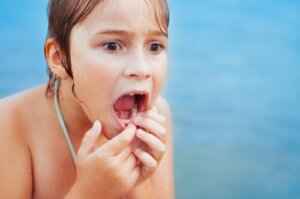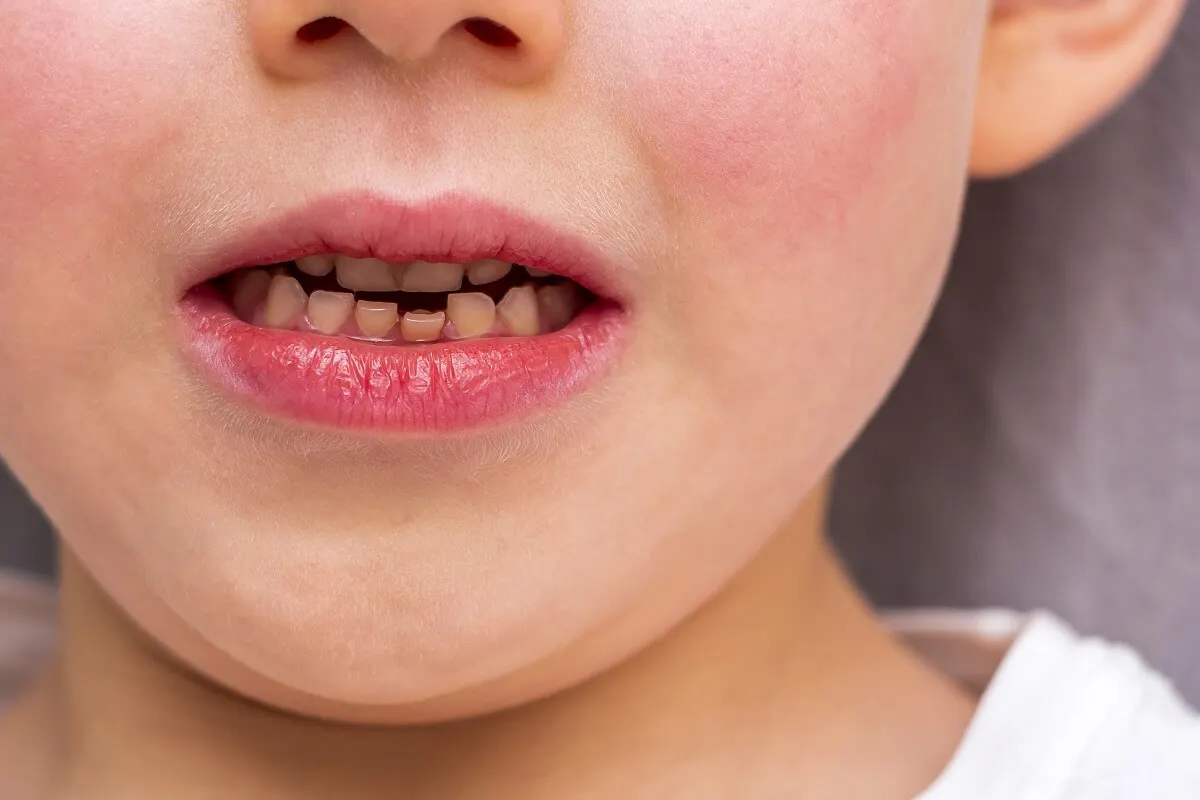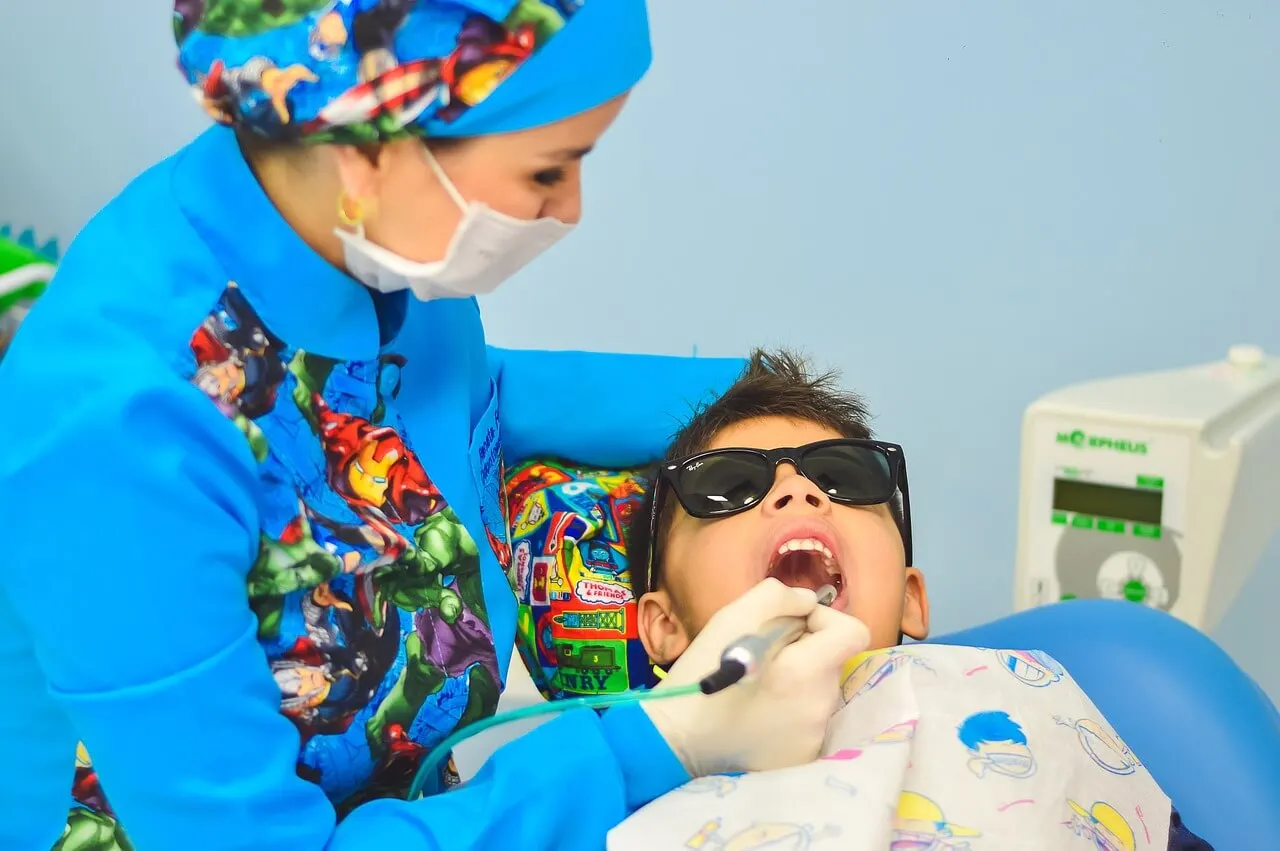What To Do If Your Child Damages a Baby Tooth


Written and verified by the dentist Vanesa Evangelina Buffa
Children are curious and restless. That’s why bumps and falls are quite frequent situations in childhood. If your child damages a baby tooth during these accidents, it’s important to know what to do.
Dental trauma can occur for different reasons and at any age. But if the affected teeth are temporary, the actions to be taken and the therapeutic measures are different from those used for permanent teeth.
It’s important to take into account the close relationship between the roots of the baby teeth that receive the blow and the permanent teeth that are forming underneath, inside the bone. This is what makes how you should address the problem different depending on the affected tooth.
In this article, we’ll tell you the reasons and symptoms of an injury to baby teeth. In addition, we’ll share a step-by-step guide on what to do if your child knocks his or her baby teeth.
Reasons why a baby tooth may be injured
The primary dentition appears between 6 and 8 months of age. At 3 years of age, there are already 20 baby teeth in the mouth that will fulfill their functions until the time of tooth replacement.
The change from baby teeth to permanent teeth happens from 6 years of age until around 12 or 13. Therefore, during almost all of childhood, there will be baby teeth that are susceptible to injuries.
Dental trauma in childhood are injuries that affect the dental elements and their supporting tissues. Most of the time they occur as a consequence of falls and domestic accidents.
In the case of the baby teeth, the most common cause is the fall of the child when he/she begins to walk and move on his/her own. These are usually blows against the floor or the edges of tables or chairs that are at their height. A lack of balance and tripping over rugs, steps, and other objects lead them to hit their mouths.
When little ones grow up, bumps in the mouth usually occur during playtime, especially when things become rough.
Falls from bicycles, swings, skates, and skateboards are other causes of dental trauma in infants. Running on wet floors and the practice of some sports can also lead to tooth injuries. Likewise, traffic accidents and child abuse can cause injuries to baby teeth.
Symptoms of tooth injuries in children
When your child hits his or her baby teeth, the trauma can manifest itself in different ways. And even if the damage is to a tooth that will eventually erupt, this is not a reason to be unconcerned.
As we mentioned earlier, the permanent elements are forming inside the bone. Therefore, a blow to a temporary tooth can have repercussions on the one that has not yet erupted.
Dental trauma in children usually occurs after the first year of life, in the preschool age, and between 8 and 10 years of age. Due to their greater exposure, the teeth most affected are the upper central incisors.
When a blow occurs in the child’s mouth we can find different situations:
- Tooth fracture: a piece of the tooth is broken in the crown or root area.
- Tooth mobility.
- Displacement of the tooth: the tooth is displaced from its usual location in the socket to the side (luxation), outwards (extrusion), or inwards (intrusion).
- Expulsion of the tooth out of the mouth (avulsion).
- Soft tissue injuries: cuts on the tongue, lips, and cheeks.
- Bone involvement: in more serious cases the bone supporting the teeth may be involved. A dentist will be able to diagnose it.

We think you may be interested in reading this, too: What Does it Mean to Dream of Your Teeth Falling Out?
What to do when your child knocks his or her baby teeth?
Knowing how to act if your child knocks his or her baby teeth is fundamental to being able to control the situation. Responding quickly and knowledgeably will help your little one feel better and will favor the prognosis of the problem.
Here are the steps you should take into account if your child knocks his or her baby teeth.
Stay calm
The moment your child knocks his or her teeth can generate tension, nervousness, and discomfort. But you should try to stay calm and focus on taking care of the child.
Most often, the soft tissues of the mouth are injured along with the tooth. And injuries to the tongue, lip, and gums are accompanied by bleeding.
Don’t panic if you see a lot of blood. Although this is a situation that can make us uneasy, it isn’t always a serious symptom.
It’s important that you do not show your anxiety to your child, and much less that you scold them or ask for explanations. You should help then to calm down, as well.
Carefully clean the wounds with a clean cloth and water and put pressure on them. This will help stop the bleeding, and at the same time, you will help the child to calm down and stop crying.
After a few minutes, the bleeding will be less and you will be able to observe the consequences of the blow. You should inspect their mouth carefully so as not to reopen the wounds. Looking at the soft tissues and teeth will allow you to assess the damange to act accordingly.
Pay attention and see if a piece of a tooth is missing, if the teeth move or are not in the usual position. Also, look to see if an element has come out or if the child cannot bite correctly. At this time it’s important to assess whether the affected pieces are temporary or permanent.
When to take the child to the dentist
If your child hits his or her baby teeth, it’s always best to take him or her to the dentist so that the professional can evaluate the situation. Often it may seem that everything is fine, but there are internal injuries that are not visible to the naked eye.
A timely evaluation and treatment can prevent future complications. Therefore, schedule an appointment with the dentist if your little one has suffered a blow.
In any case, there are specific situations in which it’s advisable to contact the pediatric dentist immediately:
- There’s a deep cut in the soft tissues.
- A piece of a tooth is missing.
- The teeth move or are in an abnormal position.
- The child cannot bite the same as before.
- One or more teeth have been knocked out of the mouth.
In these cases, it’s important to act quickly. If you notice any of these symptoms, take your child to the dentist immediately. This will improve the prognosis of the situation and avoid complications and more complicated treatments.
In the office, the professional will evaluates the situation by exploring the mouth and taking X-rays. The latter allows dentists to assess the state of the bone, the roots, and the germs of the permanent teeth that are being formed. The latter can also be affected by the blow to the baby teeth.
And depending on the diagnosis, the appropriate treatment will be carried out. If the child loses consciousness, is disoriented, or vomits after the blow, it will be necessary to go urgently to a hospital.
What to do if the baby tooth is broken or fractured
As we have already mentioned, if a tooth is broken, this is a reason to go to the dentist. It’s important to mention the tooth fracture when contacting the pediatric dentist so that he/she can prioritize your child’s care. In addition, he/she will be able to advise parents on how to act until they reach the clinic.
Tooth fractures can affect the enamel, and dentin and in the most severe cases, compromise the pulp of the tooth. In these last circumstances there will be a lot of pain and a red spot or blood will be seen in the breakage of the tooth. It requires, then, to be treated with greater urgency.
In the case of finding the fragment of the fractured dental element, it can be looked for to take it to the dental appointment. It should be transported in distilled water or warm milk and go immediately to the dentist.
The professional will evaluate whether using it or restoring the piece in another way is appropriate. But you should never try to glue the parts at home. This can be very dangerous for the child.
What to do if the baby tooth has fallen out
Another of the consequences of blows in the mouth can be the complete exit of a baby tooth out of the cavity. This is known in dentistry as tooth avulsion.
While noticing a missing tooth in your little one’s mouth can be stressful, remember to stay calm. What you need to do is compress the wound with clean gauze for a few minutes and do not touch the affected area with your hands.
Then contact your pediatric dentist immediately and tell him or her what happened. The professional will ask you for information about the type of lost piece, if the tooth has been lost in its entirety, or if you notice anything strange in the neighboring teeth.
And he/she will give you advice on how to act until you reach the dental office. You should go there urgently so that your child can be seen immediately.
Since it’s a baby tooth, the missing piece should not be reinserted into the mouth. Therefore, there’s no need to look for it and take it to the office. However, this will be indicated by the dentist during the communication.
In general, dentists often prefer not to reinsert baby teeth into their sockets. This procedure could damage the permanent element that is being formed and, given the risk, it’s always important to take care of the definitive piece.
Depending on the age of the child and the time remaining for the definitive tooth to erupt, the dentist will look for the best therapy for the case. He/she may consider placing an appliance or a prosthesis to accompany the jaw growth to save space for the correct eruption of the permanent tooth and prevent malposition.
What if the teeth move or ares out of place?
This is another of the reasons we mentioned that merits an urgent visit to the dentist. A tooth that contacts prematurely when biting or a tooth that has sunk inward or to the side should be repositioned immediately.
Because these changes not only interfere with their bite and the appearance of the child. They can also cause damage to the permanent teeth.
The dentist should assess this damage and put the teeth back in place. He will then immobilize them with splints for a period of time. If you notice these strange positions when your child knocks his or her baby teeth, you should not touch the area.
You should never try to adjust the tooth by yourself. As we mentioned, you should go to the dentist promptly so that your child receives the proper treatment.

Like this article? You may also like to read: 9 Natural and Effective Tips for Taking Care of Your Teeth
Home care
The tips we have shared so far are the ones you should practice immediately when your child knocks his or her baby teeth. But after the moment of urgency has passed and the appropriate treatment has been received, there will be other cares to consider in order to favor the recovery of the mouth:
- A soft and cold diet: offering soft, easy-to-eat, and fresh food helps to reduce inflammation in the area. Smoothies, yogurts, ice creams, jellies, and milkshakes are good options to feed your little one during the days following the injury.
- Oral hygiene: oral hygiene should not be neglected due to an injury. Brushing should be done with gentle movements and the dentist may indicate the use of a special antiseptic gel. The rest of the mouth continues to be cleaned normally.
- Avoid the use of pacifiers, teats, or the child sucking his or her thumb: this generates excessive forces in the traumatized area that hinder recovery.
- Pay attention to complications: you should observe and monitor the bruised area for the possibility of long-term complications. Pay attention to the inflammation of the gum, to a pus granite, to the change of color of the crown or that the tooth begins to move before time can indicate that something is not right. In the event of these symptoms, you should consult a pediatric dentist.
- Keep an eye on the injury: go for check-ups as often as indicated by the dentist until the permanent tooth erupts.
Prevent dental injuries
Blows in children are a fairly common situation during childhood. Play and exploration make it almost inevitable to suffer a fall that ends in tears or a bruise.
But some simple care can reduce the chances of the little ones getting hurt. Making sure that the spaces where children move around are safe is a good start. Remove small tables, rugs, and other dangerous objects when babies begin to walk. It’s also a good idea to avoid using walkers.
It’s also important to teach infants not to roughhouse. Even if it seems like fun to them, hitting other children with objects or pushing and shoving can lead to injuries.
Teachings such as not running around the edges of the pool and using the ladder when getting out of the pool or avoiding jumping off moving swings are also important. And when playing sports or riding bikes and skateboards, proper protection should be in place.
With the right care, you can reduce your child’s chances of suffering a serious injury. And if your child still knocks out his or her baby teeth, you now know what to do. By putting our advice into practice, you will be able to intervene with the knowledge and peace of mind that your child needs to face this uncomfortable moment.
All cited sources were thoroughly reviewed by our team to ensure their quality, reliability, currency, and validity. The bibliography of this article was considered reliable and of academic or scientific accuracy.
- Ávila, C., Cueto, A., & González, J. (2012). Caracterización del traumatismo dentoalveolar que afecta a los tejidos de soporte en dientes temporales. International Journal of Odontostomatology, 6(2), 157-161. https://www.scielo.cl/scielo.php?pid=S0718-381X2012000200007&script=sci_arttext
- Cagetti, M., Marcoli, P., Berengo, M., Cascone, P., Cordone, L., Defabianis, P., et al. (2019). Italian guidelines for the prevention and management of dental trauma in children. Italian Journal of Pediatrics, 45, 1-14. https://link.springer.com/article/10.1186/s13052-019-0734-7
- Kelly, O. (25 de agosto del 2024) Dental trauma. Don’t Forget The Bubbles. Consultado el 28 de octubre del 2024 https://dontforgetthebubbles.com/dental-trauma/
- la Teja, D., Villegas, L., Rodríguez, F., & Durán, L. (2016). Avulsión dental. Acta pediátrica de México, 37(2), 132-133. https://www.scielo.org.mx/scielo.php?pid=S0186-23912016000200132&script=sci_arttext
- Sánchez, T., Avila, J., Segueo, M., & Gil, L. (2016). Traumatismos dentarios en niños y adolescentes. Correo Científico Médico de Holguín, 20(4), 741-756. https://www.medigraphic.com/cgi-bin/new/resumen.cgi?IDARTICULO=69963
- Tewari, N., Bansal, K., & Mathur, V. P. (2019). Dental trauma in children: a quick overview on management. The Indian Journal of Pediatrics, 86(11), 1043-1047. https://link.springer.com/article/10.1007/s12098-019-02984-7
This text is provided for informational purposes only and does not replace consultation with a professional. If in doubt, consult your specialist.








